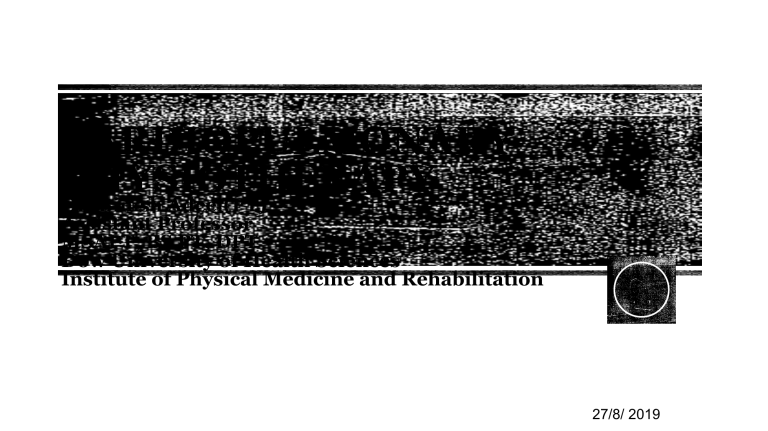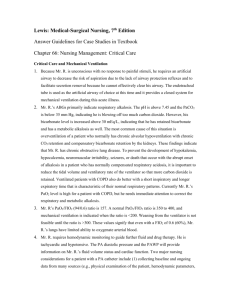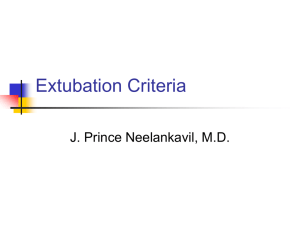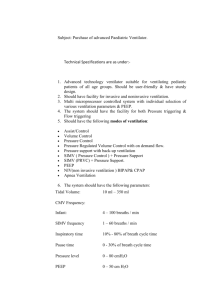
CARDIOPULMONARY PHYSIOTHERAPY Dr. Binish Adeel(PT) Assistant Professor MSAPT, BS PT, DPT Dow University of Health Sciences Institute of Physical Medicine and Rehabilitation 27/8/ 2019 MECHANICAL VENTILATION Objectives ▪ ▪ ▪ ▪ ▪ ▪ ▪ ▪ ▪ ▪ ▪ Introduction Indications Airway Principles Benefits Complications Settings Modes Positive end‐expiratory pressure High‐frequency ventilation Weaning and extubation INTRODUCTION ▪ Intermittent positive pressure ventilation (IPPV) augments or replaces the function of the inspiratory muscles by delivering gas under positive pressure to the lungs. ▪ This substitutes for the respiratory pump but is not necessarily beneficial for lung tissue, which is vulnerable to the shear forces of repetitive opening of alveoli. ▪ There is a narrow range of pressures and volumes within which the lungs are safe from either over distension or atelectasis INDICATIONS ▪ unable to ventilate adequately, oxygenate adequately or both. EG: respiratory depression due to post‐anaesthesia or drug overdose, inspiratory muscle fatigue due to exacerbation of COPD, inspiratory muscle weakness due to neurological impairment, or severe hypoxaemia due to lung parenchymal disease. ▪ Patients who are able to breathe adequately but for whom this is considered inadvisable, e.g. those with acute head injury. ▪ Patients who require intubation for airway protection or to overcome upper airway obstruction. They require some ventilatory support to compensate for the work of breathing (WOB) through the tubing. INDICATIONS ▪ Arterial Pao2 < 55‐60 mm Hg (on supplemental oxygen or CPAP) ▪ Arterial Paco2 > 50 mm Hg (absence of chronic disease) and pH < 7.32 ▪ Evidence of increased work of breathing = RR > 35/min, INDICATIONS ▪ VT < 5 mL/kg ▪ Retractions/nasal flaring ▪ Paradoxical/divergent chest motion ▪ Post operatively INDICATIONS ▪ Respiratory Arrest ▪ Acute ventilator failure (e.g. rising PaCO2 with acidosis. ▪ Respiratory muscle dysfunction, excessive ventilatory load, altered central ventilatory drive) ▪ Acute exacerbation of COPD ▪ Impending respiratory failure ▪ Severe oxygenation deficit ▪ Acute head injury ▪ To protect airway ▪ To overcome upper airway obstruction INTUBTION/ INDUCTION Intubation ▪ Insertion of ETT ▪ Patient connect to ventilator through ETT ( endotracheal tube) and tracheostomy tube OR nasal tubes. ▪ Average internal diameter sizes are 8 mm for oral and 7 mm for nasal tubes. Endotracheal tube CUFF ▪ A cuff (prevents escape of ventilating gas past the tracheal tube and inhibits large volume aspiration). ▪ Approximately 0.5 inches from the end of an endotracheal or tracheal tube is a cuff (balloon). ▪ (1) ensure that all of the supplemental oxygen being delivered by the ventilator via the artificial airway enters the lungs ▪ (2) help hold the artificial airway in place. Cuff inflation pressure should be adequate to ensure that no air is leaking around the tube; however, cuff pressures should not exceed 20 mm Hg. High cuff pressures have been linked to tracheal damage and scarring, which can cause tracheal stenosis. Complication for ETT intubation ▪ Trauma to lips, teeth, tongue and nose ▪ Hypertension, tachycardia, bradycardia and arrhythmia ▪ Raised intracranial pressure ▪ Laryngeal trauma and Laryngospasm ▪ Bronchospasm ▪ Cord avulsions, fractures and dislocation of arytenoids ▪ Airway perforation Nasal, retropharyngeal, pharyngeal, uvular, laryngeal, tracheal, esophageal and bronchial trauma ▪ Esophageal intubation ▪ Bronchial intubation ▪ Disrupted communication ▪ Swallowing difficulty ▪ Chest infection ▪ Discomfort,gagging,over salivation ▪ Sore throat ▪ Laryngeal edema ▪ Hoarseness ▪ Nerve injury ▪ Superficial laryngeal ulcers Laryngeal granuloma ▪ Glottis and subglottic granulation tissue ▪ Vocal cord paralysis ▪ Tracheal stenosis ▪ Tracheo‐oesophageal fistula PARAMETERS/SETTINGS 1. 2. 3. 4. 5. 6. 7. 8. Ventilator mode Respira tory rate Tidal volume or pressure settings Inspira tory flow I:E ratio PEEP FiO2 Inspira tory trigger Respiratory Rate ▪ A respiratory rate (RR) of 10‐15 breaths per minute ▪ High respiratory rates allow less time for exhalation, cause air trapping in patients with obstructive airway disease. Tidal Volume ▪ 5‐8 mL/kg of body weight ▪ lowest values recommended in the presence of obstructive airway disease and ARDS. Inspiratory flow ▪ Varies with the Vt, I:E and RR ▪ Normally about 60 l/min ▪ Can be majored to 100‐ 120 l/min Inspiratory/Expiratory Ratio: ▪ Normal (I/E) ratio is 1:2. ▪ Inverse ratio ventilation(4:1) used in hypoxemic patients to recruit alveoli Inspiratory pause ▪ End inspiratory hold enhance gas distribution by allowing time for recruitment of poor ventilated alveoli PEEP: ▪ Applying physiologic PEEP of 3‐5 cm H2 O is common to prevent decreases in functional residual capacity in those with normal lungs. ▪ CAN GO UPTO 20 cm H2 O Inspiratory Trigger ▪ Normally set automatically ▪ 2 modes: ▪ Airway pressure ▪ Flow triggering FiO2(fraction of inspired oxygen) ▪ Initial FiO2 set at 1.0, and then reduce ▪ Adjusted according to pao2 Two Ways to Achieve Continuous Ventilation ▪ Negative pressure ventilation ▪ Positive pressure ventilation Spontaneous Breathing Positive Pressure Breath Cycling Cycling refers to how the ventilator ends the inspiratory phase of the breath Cycling Mechanisms ▪ Volume cycling – inspiration ends when a preset tidal volume is delivered ▪ Pressure cycling – inspiration ends when a preset pressure is reached on the airway ▪ Time cycling – inspiration ends when a preset inspiratory time has elapsed ▪ Flow cycling – inspiration ends when a preset flow has been reached Triggering The mechanism that starts the inspiratory phase Trigger Mechanisms ▪ Pressure triggered – a drop in airway pressure triggers the ventilator ▪ Flow triggered – a constant (bias) flow of gas passes through the ventilator circuit. When the patient starts to inhale the ventilator detects the drop in bias flow and triggers ▪ Types of triggered breaths: patient = assisted; ventilator = controlled. MODES Positive pressure ventilation Ventilation modes can be divided into two groups: ▪ volume‐controlled modes ▪ pressure‐controlled modes volume controlled ▪ Volume constant: Attempts to achieve preset Volume ▪ Peak airway pressure: Variable. ▪ Determined by changes in airway resistance, lung compliance, or extra pulmonary pressure level. ▪ Volume control (or volume‐limited ventilation) delivers a specific minute volume at a constant flowrate ▪ using preset variables such as ▪ respiratory rate (RR), tidal volume (VT) and inspiratory :expiratory (I:E) ratio. ▪ Airway pressure rises slowly during inspiration to a peak value that varies with airway resistance and lung compliance. A pressure limit is set for safety. ▪ Volume control is commonly used for adults for three reasons: ▪ • It can be relied on to deliver a consistent minute volume regardless of airway resistance and lung compliance. ▪ • It maintains steady PaC02 levels when this is imperative, e .g. In acute head‐injured patients. ▪ Inspiratory pressure increases gradually and may cause lesser shear forces on the alveoli Pressure controlled ▪ Volume variable: Attempts to achieve preset pressures. ▪ Peak airway pressures: Fixed ▪ Pressure control (or pressure‐limited ventilation) delivers a preset pressure during inspiration, resulting in a variable VT that depends on the preset pressure, airway resistance, lung compliance, patient effort and inspiratory time. ▪ Pressure control is usually considered to be safer for patients with stiff lungs (indicated by peak airway pressure above 35 cmH20 on volume control), especially for those with ARDS, for whom it reduces the work of breathing . ▪ For babies, it limits alveolar pressures and may reduce the risk of barotrauma. Controlled mandatory ventilation(CMV) ▪ Ventilator trigger mode ▪ Fully controlled ventilation : ▪ preset rate; Fio2; VT; flow rate; I : E ratio. ▪ Reserved for patients unable to breath at all or under pharmacologic paralysis or heavy sedation, in a coma. Control Mode Assist control ▪ Patient trigger mode ▪ Patient controls initiation of breath and rate. If the patient stops breathing spontaneously, the ventilator goes into backup mode with the preset rate and VT until spontaneous inspiratory effort is sensed. Assist Mode Intermittent mandatory ventilation(IMV) ▪ Allows patient to breath spontaneously between preset number of mechanical breath. IMV – Intermittent Mandatory Ventilation Synchronized Intermittent Mandatory Ventilation (SIMV): ▪ patient receives a preset respiratory rate at a set tidal volume ▪ machine allows for the patient to breathe spontaneously during the machine breaths. ▪ If the patient breathes near the time that the machine is prepared to deliver the preset volume, the machine will deliver the preset tidal volume. ▪ The breaths that the patient initiates in between the machine breaths are not supplemented by the machine. It is usually tolerated well by the patient, because of the synchronicity involved. Pressure Support Ventilation (PSV) ▪ PSV is preset pressure that augments the patient’s spontaneous inspiratory effort and decreases the work of breathing. ▪ patient completely controls the respiratory rate and tidal volume. ▪ PSV is used for patients with a stable respiratory status and is often used with SIMV to overcome the resistance of breathing through ventilator circuits and tubing. Continuous Positive Airway Pressure (CPAP): ▪ Used either intermittently during long‐term weaning as a way to strengthen the muscles, or as a final step before removing the patient from the ventilator, to see how they tolerate the lack of ventilatory assistance. ▪ All breaths are generated by the patient, and the patient’s effort determines the tidal volume. ▪ The machine simply provides a continuous airway pressure, supplemental oxygen, and apnea alarms. The continuous airway pressure makes the effort of breathing easier for the patient. Positive End Expiratory Pressure (PEEP) ▪ PEEP is positive pressure that is applied by the ventilator at the end of expiration. ▪ This mode does not deliver breaths, but is used as an adjunct to CV, A/C, and SIMV to improve oxygenation by opening collapsed alveoli at the end of expiration. ▪ Pressures vary from 3 cmH20 to over 20 cmH20 ▪ In healthy adults, 5 cmH20 of PEEP raises ▪ FRC by 400‐500 mL Benefits ▪ Stability of alveoli and conservation of surfactant . ▪ Resting lung volume raised out of the range of airway closure ▪ Increased alveolar availability for gas exchange. Disadvantages ▪ Excess PEEP can cause hyperinflation ▪ Impairs venous return and cardiac output. ▪ Hemodynamic compromise usually occurs at over 1 5 cmH20 PEEP in normovolaemic patients ▪ Increases the risk of barotrauma in patients who have lung disease, especially in hyperinflation conditions Precautions ▪ High‐level PEEP should be avoided in undrained pneumothorax ▪ with caution in surgical emphysema, bulla or bronchopleural fistula. ▪ Hypervolemia is a relative contraindication, but if necessary , use inotropes support. ▪ above 10 cmH20, manual hyperinflation requires certain precautions Best PEEP ▪ Effective PEEP increases lung compliance and boosts Sa02, excessive PEEP decreases compliance by over‐distending alveoli ▪ 'Physiological' PEEP at 3‐5 cmH20 is routinely applied in order to maintain alveolar stability, and is especially useful in low lung volume states to prevent progressive parenchymal injury. ▪ Higher levels of PEEP promote gas exchange and reduce the necessity for toxic levels of inspired oxygen. ALARMS Alarms and Common Causes High Pressure Limit Low Pressure High Respiratory Rate Low Exhaled Volume • Secretions in ETT/airway or condensation in tubing • Kink in vent tubing • Patient biting on ETT • Patient coughing, gagging, or trying to talk • Increased airway pressure from • Ventilator tubing not connected • Displaced ETT or tracheostomy tube • Patient anxiety or pain • Secretions in ETT/airway • Hypoxia • Hypercabnia • Ventilator tubing not connected • Leak in cuff or inadequate cuff seal • Occurrence of another alarm preventing full delivery of breath COMPLICATIONS Barotrauma ▪ Barotrauma is extra‐alveolar aIr, e.g. pneumothorax. The name arose from assumptions that the cause was excess pressure, because affected patients tend to have high peak pressures. ▪ Excess volume is the cause, because sustained alveolar distension can rupture the delicate alveolar capillary membrane ▪ Pneumothorax ▪ Pneumomediastenum ▪ Subcutaneous emphysema Displaced ventilation ventilation abolished in dependent area of lungs ▪ Positive pressure gas takes the path of least resistance which is to the more open upper regions. ▪ The diaphragm is inactive and it is irrelevant that its dependent fibers are more stretched by abdominal viscera. ▪ Increased dead space ▪ Dead space increases because of reduced overall ▪ perfusion, and to a lesser extent because of distension of ventilator tubing. Ventilation perfussion mismatched ▪ Disturbed ventilation and perfusion gradients, and increased dead space, result in VA/Q mismatch Gut dysfunction ▪ Decrease perfusion increase permeability increase incidence of bleeding, paralytic ileus and ulcer ▪ Delay gastric emptying Absorption atelectasis ▪ During 100% oxygen delivery, OXygen is extremely soluble in blood and diffuses very quickly into the pulmonary vasculature. if in fact, that not enough gas is left in the alveoli to maintain patency, and the alveolus collapses; this is known as absorption atelectasis. Excess secretions ▪ Irritation from ETT ▪ Impaired mucuociliary clearance system Weak inspiratory muscles ▪ atrophy Ventilator­associated pneumonia (VAP) ▪ Develops at a rate of approximately 1% per day and has an attributable mortality rate as high as 20–50%. ▪ Hand washing, elevation of the head of the bed, non‐nasal intubation, and proper nutrition all reduce the rate of VAP. ▪ Avoidance of unnecessary antibiotics decreases the risk of VAP with a resistant pathogen. ▪ WEANING Weaning requires: ▪ progressive reduction In support so patient is able to sustain spontaneous breathing ▪ trial of spontaneous breathing through the tracheal tube ▪ Extubation. Weaning criteria ▪ Reversal of primary problem causing need for ventilation ▪ Patient awake and responsive ▪ Good analgesia, ability to cough ▪ Reducing or minimal doses of inotropic support Ideally ▪ Functioning bowels, absence of abdominal distension ▪ Normalizing metabolic status ▪ Adequate hemoglobin concentration cont. ▪ Minute ventilation>10l/mint ▪ Vital capacity>10ml/kg ▪ Respiratory rate<35 ▪ Tidal volume>5ml/kg ▪ maximum inspiratory pressure > 20 cmH20 ▪ Pa02 > 60mmHg on 40% oxygen and 5cm PEEP Weaning process Reduction in ventilatory support by ▪ Decreased number of breaths in SIMV mode or ▪ Decreased pressure in PS mode. Steps of weaning ▪ Explanations ▪ patient takes up in preferred posture, usually sitting upright. ▪ Humidified oxygen is connected to the tracheal tube by a T‐piece ▪ airway suctioning if necessary. ▪ patient is disconnected from the ventilator, given oxygen, encouraged to breathe, and monitored for signs of labored breathing, anxiety, desaturation, fatigue or drowsiness ▪ If the diaphragm tires, it may need 24 hours to recover, and it is better to return the patient to respiratory support than to await respiratory distress Extubation Removal of Endotracheal tube Criteria for Extubation ▪ can maintain a patent airway. ▪ can protect the airway from aspiration. ▪ can maintain a clear chest. ▪ reason for intubation has been alleviated. ▪ Able to cough ▪ sustainable 30‐60 minutes of spontaneous breathing Steps for Extubation ▪ Give physiotherapy or simply suction the airway. ▪ Sit the patient upright. ▪ Explain how the tube will be removed ▪ Suck out the mouth and throat to clear secretions ▪ Cut the tape holding the tube a fresh catheter to reach just distal to the tip of the tube, deflate the cuff, slide the tube out in a gentle downward curve, suctioning during withdrawal. ▪ Encourage the patient to cough out ▪ Give oxygen, non‐invasive ventilation ▪ monitors and breathing pattern, listen for stridor. REFERENCES ▪ Physiotherapy in respiratory care by alexander hough ▪ Nancy D Ciesla. Chest Physical Therapy for Patients in Intensive Care Unit ;PHYS THER.1996;76:609‐625. ▪ Susan berney et al, physiotherapy in critical care in austrailia, CPTJ Vol 23 /1 march 2012 ‘19‐23. ▪ Wai pong wong,physical therapy for patient in acute respiratory failure.PT. vol 80. july 2000:662‐669. THANK YOU




